Unit 8 Is there a post office near here单元复习课件(词组+句型+知识点+语法+写作指导+易错考点)
文档属性
| 名称 | Unit 8 Is there a post office near here单元复习课件(词组+句型+知识点+语法+写作指导+易错考点) | 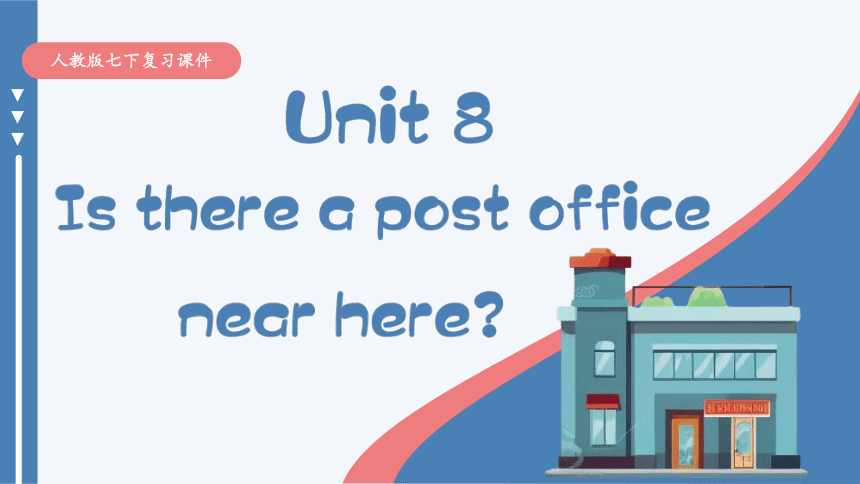 | |
| 格式 | pptx | ||
| 文件大小 | 39.6MB | ||
| 资源类型 | 试卷 | ||
| 版本资源 | 人教新目标(Go for it)版 | ||
| 科目 | 英语 | ||
| 更新时间 | 2024-05-27 15:49:58 | ||
图片预览

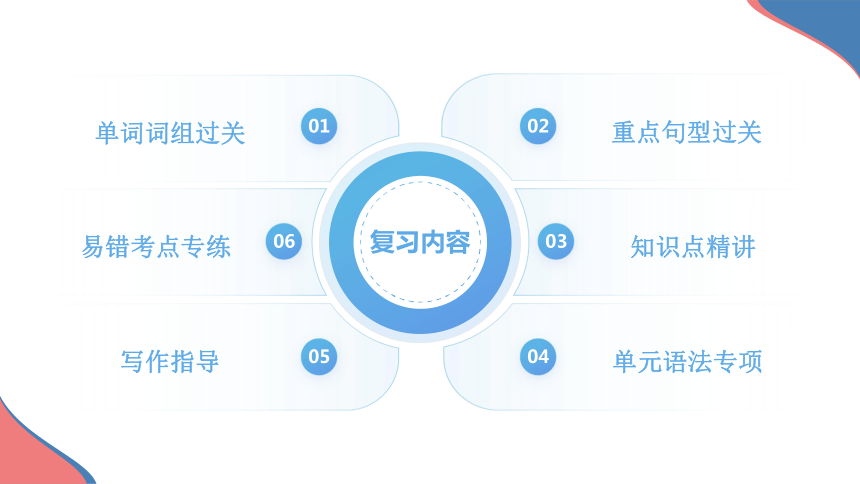

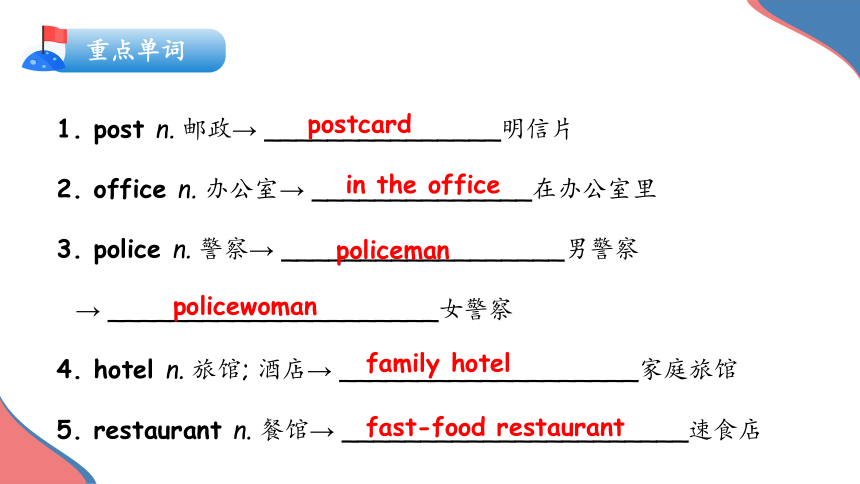
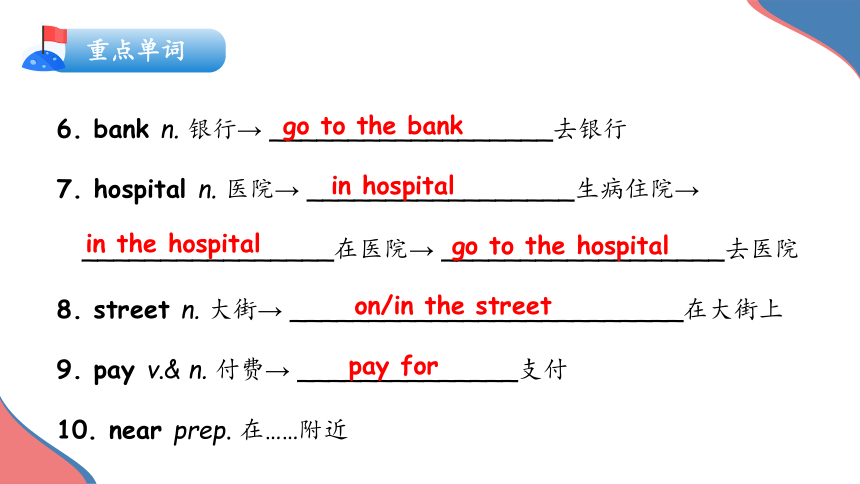
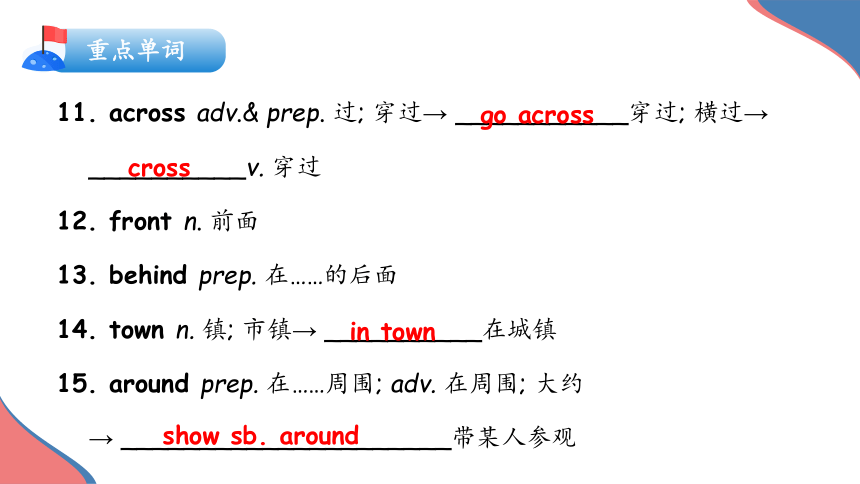

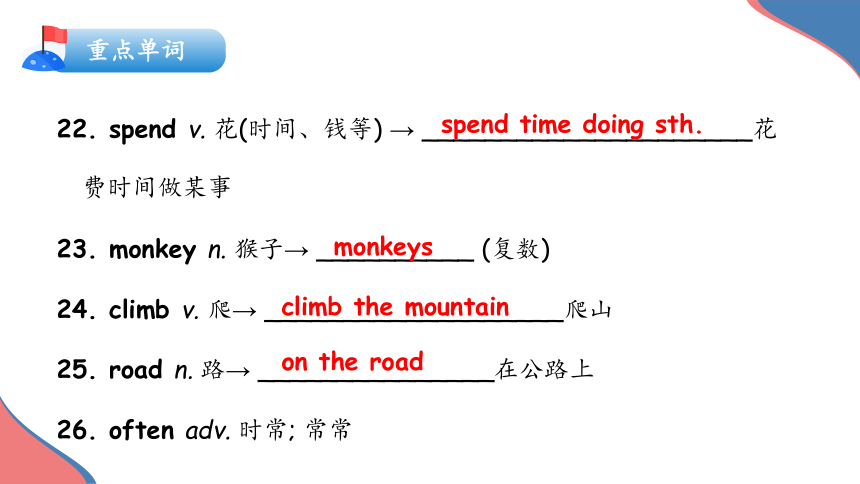
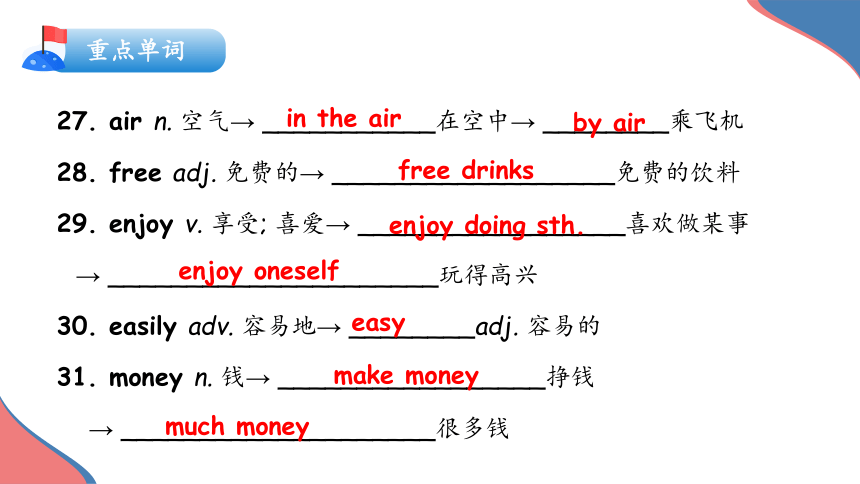
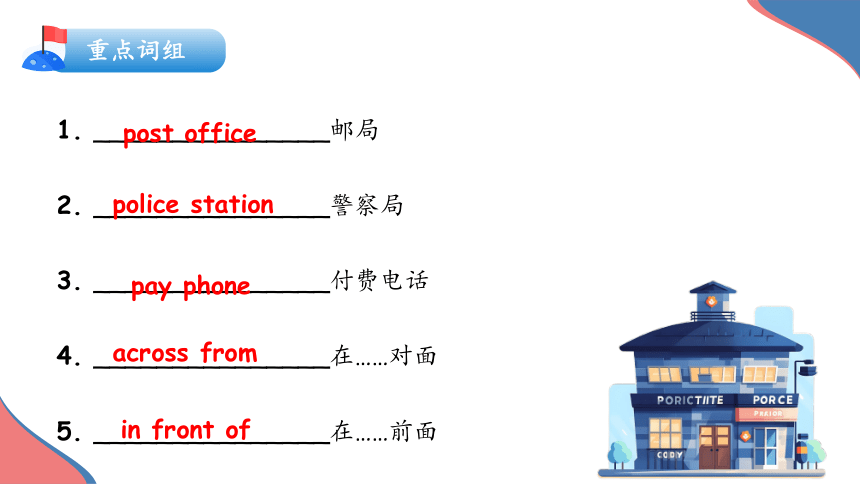
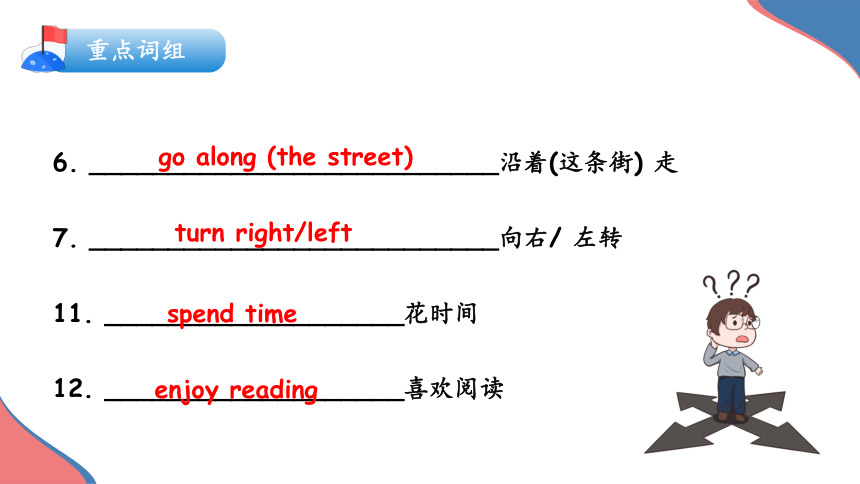

文档简介
(共151张PPT)
人教版七下复习课件
复习内容
写作指导
易错考点专练
单词词组过关
单元语法专项
知识点精讲
重点句型过关
01
06
05
02
04
03
重点单词
1. post n. 邮政→ _______________明信片
2. office n. 办公室→ ______________在办公室里
3. police n. 警察→ __________________男警察
→ _____________________女警察
4. hotel n. 旅馆; 酒店→ ___________________家庭旅馆
5. restaurant n. 餐馆→ ______________________速食店
postcard
in the office
policeman
policewoman
family hotel
fast-food restaurant
重点单词
6. bank n. 银行→ __________________去银行
7. hospital n. 医院→ _________________生病住院→ ________________在医院→ __________________去医院
8. street n. 大街→ _________________________在大街上
9. pay v.& n. 付费→ ______________支付
10. near prep. 在……附近
go to the bank
in hospital
in the hospital
go to the hospital
on/in the street
pay for
重点单词
11. across adv.& prep. 过; 穿过→ ___________穿过; 横过→ __________v. 穿过
12. front n. 前面
13. behind prep. 在……的后面
14. town n. 镇; 市镇→ __________在城镇
15. around prep. 在……周围; adv. 在周围; 大约
→ _____________________带某人参观
go across
cross
in town
show sb. around
重点单词
16. north n. 北; 北方 adj. 北方的
→ __________________在……的北方
17. along prep. 沿着
18. turn v. 转向; 翻→ ______________ 转向……
19. right adv. 向右边 n. 右边→ ______________ 在右边
20. left adv. 向左边 n. 左边→ ______________ 在左边
21. crossing n. 十字路口→ ___________ v. 穿过
→ ________________________ 在第一个十字路口
in the north of
on the right
on the left
turn to...
cross
at the first crossing
重点单词
22. spend v. 花(时间、钱等) → _____________________花费时间做某事
23. monkey n. 猴子→ __________ (复数)
24. climb v. 爬→ ___________________爬山
25. road n. 路→ _______________在公路上
26. often adv. 时常; 常常
spend time doing sth.
monkeys
climb the mountain
on the road
重点单词
27. air n. 空气→ ___________在空中→ ________乘飞机
28. free adj. 免费的→ __________________免费的饮料
29. enjoy v. 享受; 喜爱→ _________________喜欢做某事
→ _____________________玩得高兴
30. easily adv. 容易地→ ________adj. 容易的
31. money n. 钱→ _________________挣钱
→ ____________________很多钱
in the air
by air
free drinks
enjoy doing sth.
enjoy oneself
easy
make money
much money
重点词组
1. _______________邮局
2. _______________警察局
3. _______________付费电话
4. _______________在……对面
5. _______________在……前面
post office
police station
pay phone
across from
in front of
重点词组
6. __________________________沿着(这条街) 走
7. __________________________向右/ 左转
11. ___________________花时间
12. ___________________喜欢阅读
go along (the street)
turn right/left
spend time
enjoy reading
重点句型
1. —_______ _______ a hospital near here
这附近有医院吗
—Yes, there is. 是的, 有。
2. The pay phone ________ ________ ________ the library.
付费电话在图书馆对面。
is across from
Is there
重点句型
3. ___________ the hospital 医院在哪儿
4. ______________________ 我怎么帮你呢
5. —_______ _______ any restaurants near here
这附近有餐馆吗
—Yes, there’s one _______ _______ _______ _______ the post office. 是的, 在邮局前面有一家。
Where’s
How can I help you
Are there
in the north of
重点句型
6. _________ _________ Long Street and it’s on the right.
沿着长街走, 它在右边。
7. _________ _________ at the first crossing and the restaurant is _________ _________ _________, across from the pay phone. 在第一个十字路口向右转, 餐馆在你的左边, 付费电话的对面。
Go along
Turn right
on your left
重点句型
8. I love to ________ the monkeys __________ around.
我喜欢看猴子们四处攀爬。
9. ________ ________ ________, I usually walk out and turn right on Bridge Road.
要到达那儿, 我通常步行出去, 在大桥路向右拐。
watch climbing
To get there
重点句型
10.I _________ _________ _________ on school days, but I have some _________ time on weekends.
在上学的日子里我非常忙, 但在周末我有一些空闲的时间。
am very busy
free
知识点1:police /p 'li s/ n. 警察
考向①:police 是集体名词, 是“警察”的总称, 即指“警察部门”或“多个警察”,前面经常加the。
考向②:作“警察”讲时相当于policewomen and policemen, 谓语动词用复数形式。
知识点1:police /p 'li s/ n. 警察
易错点:
表示“一名警察”时不能用a police, 应该
用a policeman(一名男警察)
a policewoman(一名女警察)。
知识点1:police /p 'li s/ n. 警察
e.g. The police are searching for a man with a beard.
警察正在搜寻一个留胡子的人。
What is your dream job, a pilot or a policeman
你梦想的工作是什么,是飞行员还是警察?
知识点1:police /p 'li s/ n. 警察
易错点:
与police 用法类似的词有people。这类词表示单数概念时, 要改用别的词汇。如:people → a person。
典型例题
警察正在帮助这些孩子。
__________ ___________ __________ helping the children.
The police are
知识点2:Is/Are there... 有……吗?
考向:此句型用于问路。肯定回答“Yes, there is.”;
否定回答“No, there isn’t.”。
e.g. —Is there a bookstore near here 这附近有书店吗?
—No, there isn’t. 不,没有。
易错点:
there 和 be 连用,不和 have/has 连用。
e.g. 今天将有一场比赛。
There will be a match today.( √ )
There will have a match today.( x )
知识点2:Is/Are there... 有……吗?
知识点2:Is/Are there... 有……吗?
辨析: there be 与have/has
there be 表示“某处有某物/人”, 指客观存在。句型为“There be+某物/人+某地.”。句中有两个或多个并列主语时, be动词的形式要与最靠近的主语在数上保持一致, 即遵循“就近原则”。
have/has 表示“某人/物有”, 指从属关系。句型为“某人/物+have/has+ 某物.”。用have 或has 取决于句子的主语。
知识点2:Is/Are there... 有……吗?
e.g. There is a pen and two pencils in my pencil box.
在我的铅笔盒里有一支钢笔和两支铅笔。(钢笔和铅笔
不一定是属于我的)
There are two pencils and a pen in my pencil box.
在我的铅笔盒里有两支铅笔和一支钢笔。
I have a pen and two pencils.
我有一支钢笔和两支铅笔。(钢笔和铅笔是属于我的)
He has a car. 他有一辆汽车。
典型例题
桌子上有一支钢笔和一些书。(be)
___________________ and some books on the desk.
There is a pen
知识点3:hospital /'h sp tl/ , /'hɑ sp tl/n. 医院
辨析: in hospital 与in the hospital
in hospital 指“生病住院”, hospital 是一个抽象名词。
in the hospital 指“在医院”, 可能是到医院工作, 可能是看护病人。由于有了定冠词the的限制, hospital成了一个具体指某个地点的名词。
e.g. His mother is in hospital. 他妈妈住院了。
There are many people in the hospital. 医院里有很多人。
知识点4:near/n , n r/ prep. 在……附近
考向:介词,在……附近,相当于close to。
e.g. You will also find small shops near the train station.
你还会在火车站附近找到小商店。
The bank is near/close to the zoo.
银行在动物园附近。
知识点4:near/n , n r/ prep. 在……附近
拓展:near 的常见用法:
near 形容词,“近的”,反义词是far“远的”。
e.g. The hotel is very near. 这家旅馆非常近。
副词,“在附近”。
e.g. Come near and enjoy the picture.
靠近点,欣赏一下这幅画。
知识点5:on Bridge Street 在大桥街上
e.g. She lives on Center Street.
她住在中心大街上。
专有名词,首字母大写
易错点:
表示“在街上”,英式英语用“in the street”,
美式英语用“on the street”。
如果接门牌号,则都用at。
知识点5:on Bridge Street 在大桥街上
拓展: 街道名称与介词的连用
“on+街道名称” 在……街/ 路上 My house is on Nanjing Road.
我家在南京路上。
“at+门牌号+街 道名称”在……街/ 路……号 Mr Green lives at No. 66 Center Street.
格林先生住在中心大街66 号。
典型例题
I often go to the bookstore _______ Quancheng Road
although it’s crowded(拥挤的).
A. on B. for
C. with D. between
【点拨】用固定搭配法。“on/in + 街道名称”表示“ 在…… 街或路上”。
知识点6:pay 的用法
含义 用法 示例
n. 工资, 薪水 表示“薪水不错/ 低”用good/low Do you get good pay
你的工资高吗?
v. 付费 pay sb. 付钱给某人 The boss pays the workers every month.
老板每月都给工人发薪水。
pay for sth. 为某物付钱 You may either bring a lunch box or pay for lunch at our restaurants. 你可以带一个午餐盒,也可以在我们餐厅买午餐。
pay...for sth. 买某物付……钱 You need to pay 8, 000 yuan for the computer.
你需要付八千元买这台电脑。
典型例题
— Excuse me, is this coat yours
—Yes. I ________ 300 yuan ________ it.
A. payed; in B. paid; for C. paid; on
【点拨】pay money for sth.“为某物付多少钱”。
知识点7:across from 在……对面
考向:across from 是固定短语, 其后接表示地点的名词或代词,意为“在……对面”。
e.g. The pay phone is across from the bank.
付费电话在银行的对面。
He sat across from me and waited to see the result.
他坐在我的对面,等着看结果。
He lives in the house across from/opposite/on the other
side of ours. 他住在我们对面的那个房子里。
易错点:
across from
=opposite
= on the other side of...
在……的对面
知识点7:across from 在……对面
典型例题
书店在超市的对面。
The bookstore is ________ ________ the supermarket.
across from
知识点8:across from 在……对面
考向:across 既作副词也作介词,常与walk、go、swim 等词连用。
e.g. Can you swim across 你能游过去吗?
I can swim across the river in 10 minutes.
我可以在十分钟之内游过这条河。
知识点8:across from 在……对面
辨析: across, over 与through
across 指从物体表面横向穿过, 由一边到另一边。
over 多指从物体上方翻越或跨越。
through 强调从物体内部或空间穿过。
一语辨异:
When we walk through the park, we see a car going across the bridge and a plane flying over our head.
当我们步行穿过公园时,我们看到一辆汽车从桥上经过、一架飞机从我们头顶上方飞过。
知识点8:across from 在……对面
知识点8:across from 在……对面
拓展:cross 作动词,意为“横过;穿过”,
相当于go/walk across。
e.g. Don’t cross ( = go across) the road when the traffic lights
are red.
当交通灯是红色时,不要横过马路。
典型例题
A new bridge was built _______ the Yellow River last
year.
A. around B. across
C. against D. along
【点拨】around 围绕;across 横穿;against 紧靠;along 沿着。根据常识可知桥应该是横跨黄河。
典型例题
Look! The traffic light is green. We can go ________
the road now.
A. across B. above
C. below D. against
知识点9:next to 在……近旁, 紧邻
考向:next to 在……近旁, 紧邻
e.g. The notebook is next to the pencil case.
笔记本在铅笔盒的旁边。
方位介词短语,表空间位置,与beside 同义
知识点9:next to 在……近旁, 紧邻
辨析: next to 与near
next to next to有“紧挨着”之意, next to比near靠得更近。 Peter sits next to Mike.
彼得紧挨着迈克坐。
near 从空间讲near 只表示 “在……附近”。 Peter sits near Tom.
彼得坐在汤姆附近。
典型例题
他旁边的那位女士是我的姑姑莉兹。
The woman _________ ________ him is my aunt Liz.
next to
知识点10:between...and... 在……和……之间
考向:between...and...连接两个并列成分,只限于两者之间。
可以表示地点的概念和时间的概念。
e.g. The pay phone is between the bank and the hotel.
付费电话在银行和旅馆之间。
You sit between him and me.
你坐在我和他之间。
后接人称代词时用其宾格形式
典型例题
约翰尽力在工作和娱乐中获得平衡。
John does his best to keep the balance __________ work ________ play.
between
and
知识点11:front/fr nt/ n. 前面
反义词:back“后面”
词组:the front of... ...的前面
e.g. Lucy, come to the front of the classroom, please.
露西, 请到教室前面来。
联想记忆:
in front of 反义词 behind
in the front of 反义词 at the back of
知识点11:front/fr nt/ n. 前面
辨析: in front of 与in the front of
in front of 强调一个物体在另一个物体外部的前面 The dog is in front of the bus.那只狗在公共汽车的前面。
in the front of 强调一个物体在另一 个物体内部的前面 The driver is in the front of the bus.
司机在公共汽车的前部。
典型例题
—Why are you standing, Alice
—I can’t see the blackboard clearly. Two tall boys are
sitting _______ me.
A. behind B. next to C. between D. in front of
【点拨】用逻辑推理法。看不清黑板的原因是两个高个子男生坐在“我”的前面,故可知答案。
知识点12:behind /b ha nd/ prep. 在……的后面
e.g. There is a cat behind the door.
门后面有一只猫。
His family are right behind him.
他的家人完全支持他。
介词,表示“支持”
知识点12:behind /b ha nd/ prep. 在……的后面
辨析: behind 与after
behind 常用于表示位置或方向上的“在……的后面” They may be in front of a big rock or behind a tree. 它们可能在一块大岩石的前面或一棵树的后面。
after 常用于表示时间上的 “在……之后”。 Let’s watch a film after dinner.
晚饭后我们看一场电影吧。
一语辨异:
After an hour, we got to the cafe behind the bookstore.
一个小时之后,我们到达了书店后面的咖啡馆。
知识点12:behind /b ha nd/ prep. 在……的后面
典型例题
Anna is taller than me. She sits ______ me in the classroom.
A. between B. from
C. behind D. among
知识点13:excuse me 劳驾;打扰一下
考向:用于向陌生人求助,其中excuse 作动词,意为“原谅,宽恕”。
e.g. Excuse me. Is there a hospital near here
打扰一下。这儿附近有医院吗?
易错点:
回答 “Excuse me...”时,应该说 Never mind.
That’s all right.(没关系 。)
“Certainly.(当然。)”。
拓展:(1) excuse me 还可用于以下场合:
用法 示例
和别人谈话时要出去或做别的事时 Excuse me, just a minute.
对不起,稍等一下。
表示失礼,请求原谅时 Excuse me for troubling you.
抱歉,打扰你们了。
客气地纠正别人的话时 Excuse me, I think you are wrong.
对不起/ 失敬了,我认为你错了。
客气地请求许可时 Excuse me, but can I go out for a while
对不起,我能出去一会儿吗?
知识点13:excuse me 劳驾;打扰一下
(2) Sorry. ( = I’m sorry.) 意为“抱歉;对不起”。通常用于表示由于某种过失或办不成某事的一种歉意。
回答时常用“That’s OK. / That’s all right. / It doesn’t matter.”等。
e.g. — I’m sorry I’m late.
对不起,我迟到了。
—That’s OK. 没关系
知识点13:excuse me 劳驾;打扰一下
(3)excuse 也可作名词,意为“借口,理由”。
e.g. Late again! What’s your excuse this time
又迟到了!你这次有什么借口?
It gives me an excuse to take the car.
这使我有理由开车去。
典型例题
—_______, could you tell me when the movie will start
—At 7 o’clock in the evening.
A. Thank you B. Don’t worry
C. Excuse me D. All right
【点拨】由后面“你能告诉我电影什么时候开始吗”可知是向别人求助,此处应用“打扰;劳驾”。
知识点14:How can I help you 我怎么帮你呢?
考向:交际用语。本句是向别人提供帮助时的常用语。
回答时不需要用yes 或no, 直接说明需要帮忙的事即可。
“向别人提供帮助”的其他表达法:
May/ Can I help you
What can I do for you
Let me help you. (=Let me give you a hand.)
Would you like me to help you
知识点14:How can I help you 我怎么帮你呢?
e.g. —How can I help you 我怎么帮你呢?
—I’d like to send this letter to my brother.
我想把这封信寄给我哥哥。
—What can I do for you 我可以为你做什么吗?
—I’m looking for a book named Jane Eyre.
我正在找一本叫《简·爱》的书。
知识点14:around/ ra nd/ prep. 在……周围;到处,各处
词组:around the world=across the world
=all over the world。意为“全世界”,
e.g. They are sitting around the fire.
他们正围火而坐。
I hope I can travel around the world one day.
我希望有一天我能环游世界。
知识点14:around/ ra nd/ prep. 在……周围;到处,各处
拓展: around 还可用作副词, 用法如下:
副词 around “围绕”, 常用于动词后, 作状语。 They make the wheels go around.
他们使这些轮子转动起来。
“大约”, 用于数字前, 相当于about。 He usually reads China Daily
around/about 6: 00 a.m. 他通常在早晨大约6点钟看《中国日报》
知识点15:far from 远离
考向:far from 相当于far away from, 通常不与具体数字连用,若出现具体数字,常用away from。
e.g. My home is not far(away) from our school.
我的家离我们学校不远。
The station is two kilometers(away) from here.
车站离这儿有两千米远。
典型例题
让我们一起去看湖景。它离这儿并不远。
Let’s go to see the lake. It’s not _______ _________here.
far from
知识点16:along / 'l , 'l / prep. 沿着
考向:along相当于down,可以和go,walk 等动词连用
表示“沿着……走”还可以用固定短语:go down;walk along
walk down
e.g. There are several schools along the route.
沿途有好几所学校。
Go along/down the street, and you’ll find it.
沿着这条街走, 你就会找到它。
知识点16:along / 'l , 'l / prep. 沿着
拓展:along 还可用作副词,意为“向前;一同”。与动词连用时,常与on 同义,表示“向前移动”。
e.g. Please go along with us.
请与我们一同前往。
典型例题: The girl takes her dog for a walk _______ the river
every evening.
A. in B. along C. over D. under
知识点17:turn /t (r)n/ v. 转向
考向:turn right/left at the + 序数词+ crossing
= take the + 序数词+crossing + on the right/left
在第几个十字路口向右/ 左转
e.g. Turn left at the second crossing and go along the street.
=Take the second crossing on the left and go along the street.
在第二个十字路口向左转,然后沿着这条街走。
The boy turns his face to his mother.
这个男孩转过脸朝向他妈妈。
拓展: turn 其他的用法总结
用法 示例
动词, 意为“翻”。 Please turn to page 2.
请翻到第2 页。
系动词, 意为“变成”, 表示变化, 后跟形容词作表语。 Trees turn green in spring.
春天树变绿了。
名词, 意为“(依次轮到的)机会” It’s your turn to clean the room. 轮到你打扫房间了。
名词, 意为“拐弯处”。 Make a left turn into West Street. 向左拐入西大街。
知识点18:right /ra t/ adv. 向右边 n. 右边
e.g. Turn right at the second crossing. You’ll see the market on your
right.
在第二个十字路口向右拐。你会看到市场在你的右边。
Take the first street on the right.
走右手的第一条街。
The Student Union is in the first building on your right.
学生活动中心就在你右边第一栋建筑里面。
知识点18:right /ra t/ adv. 向右边 n. 右边
right 的相关短语:
① turn right = turn to the right
向右转
② on the right (of) 在(……的)右边
③ on one’s right 在某人的右边
知识点18:right /ra t/ adv. 向右边 n. 右边
right 一词多义
adj. 正确的, 合适的
adj. 右边的
adv. 正好, 恰好
知识点18:right /ra t/ adv. 向右边 n. 右边
一语辨异:
You are right. The bank is right on
the right side of the street.
你是对的。银行恰好在街道右边。
典型例题
同学们, 请靠马路右边行走。
Boys and girls, please walk ___________________ side of the
road.
on/along the right
知识点19:spend /spend/ v. 花(时间、钱等)
e.g. Mr. Brown likes spending time with his family on weekends.
布朗先生喜欢周末和家人共度时光。
Some women like to spend money on clothes.
一些女人喜欢在衣服上花钱。
Bob spends a lot of time playing basketball.
鲍勃花大量时间打篮球。
知识点19:spend /spend/ v. 花(时间、钱等)
spend 的常见用法:
① spend time with sb. 和某人共度时光
② spend some money/time on sth.
在某事上花费一些金钱/时间
③ spend some money/ time (in)doing sth.
花费一些金钱/时间做某事
辨析:spend, pay, cost与take
spend Sb. spend(s) time/money on sth. Sb. spend(s) time/ money doing sth. 某人花时间/金钱在(做) 某事上。 他花10美元买的这本书。
He spent $10 on the book.
=He spent $10 buying the book. =He paid $10 for the book. =The book cost him $10.
pay Sb. pay(s) money for sth. 某人支付多少钱买某物。 cost Sth. cost(s) sb. money. 某物花某人多少钱。 辨析:spend, pay, cost与take
take It takes sb. some time to do sth. =Sb. spend(s) some time (in) doing sth. 做某事花了某人多长时间。 It took me seven days to finish the task. =I spent seven days finishing the task. 我花了七天时间完成这项任务。
“各种花费的表达”:
take 花时间,cost 与 pay 花金钱,
spend花费时间与金钱;
人作主语pay与spend,
物作主语cost, it 作主语用take。
知识点19:spend /spend/ v. 花(时间、钱等)
典型例题
Jim, you’d better not _______ too much time on your
mobile phone.
A. cost B. spend C. take D. pay
【点拨】用固定搭配法。句意为“Jim,你最好不要花太多时间在手机上”。spend time on sth. 是固定搭配,意为“花费时间在某事上”
知识点20:watch/w t / v. 观看
考向:watch 用作名词,意为“手表”,复数形式为watches。
与watch 有相同用法的感官动词有see,hear,notice 等。
典型例题:—Where is your grandfather
—He’s watching my brothers _______ basketball. He always likes watching them _______ it.
A. playing; playing B. playing; play
C. play; play D. play; playing
辨析:watch sb. doing sth.与watch sb. do sth.
watch sb. doing sth. 观看某人正在做某事(强调动作正在进行) The young mother is watching her little son playing games.
那个年轻的妈妈正在看她的小儿子做游戏
watch sb. do sth. 观看某人做了某事(强调动作的整个过程或看到动作经常发生) I watched Jack go out.
我看到杰克出去了。
Let’s watch them play football.
咱们看他们踢足球吧。
知识点21:to get there 要到达那儿
考向:该短语是"to do ...“短语,即动词不定式短语,在句中作目的状语,可放在句首起强调的作用,也可放在句末。
e.g. To learn English well, he needs a dictionary.
为了学好英语, 他需要一本词典。
拓展:动词不定式(短语)在句中还可作主语、宾语、宾语补足语、定语等。
e.g. He works day and night to make money.
他夜以继日地工作来赚钱。
典型例题
_______ the online shopping, my grandma bought a
smartphone.
A. Enjoyed B. Enjoying
C. Enjoy D. To enjoy
【点拨】用语法分析法。分析句意可知,奶奶买智能手机是为了体验网购的快乐,故应用动词不定式表示目的。
知识点22:free /fri / adj. 免费的
e.g. You need not pay—it is free.
你不必付钱——这是免费的。
Here is your free lunch.
这是你的免费午餐。
作表语
作定语
知识点22:free /fri / adj. 免费的
拓展:
(1) free 意为“空闲的”,反义词是busy“繁忙的”。
When he is free, he writes novels and sings operas.
当他有空的时候,他写小说、唱歌剧。
(2)“自由的,无拘无束的”,副词形式是freely。
You are free to read here. 你可以在这里自由阅读。
典型例题
The best things in life are _______ such as the clean air
and sunshine we have in Yunnan.
A. free B. old C. expensive D. new
免费的 老的 昂贵的 新的
知识点23:enjoy / n'd / v. 享受;喜爱
考向:enjoy 后跟名词、代词或动词的-ing 形式。
enjoy 的常见用法:
① enjoy sth. 喜欢某物
② enjoy doing sth. 喜欢/喜爱做某事
③ enjoy oneself = have fun/have a good time
过得愉快;玩得开心
知识点23:enjoy / n'd / v. 享受;喜爱
e.g. I really enjoyed that meal.
那顿饭我吃得很高兴。
Sue enjoys listening to music in her free time.
休在闲暇时喜欢听音乐。
Fenghuang Ancient Town is a beautiful place in Xiangxi.
You can enjoy yourself there.
凤凰古城是湘西的一个美丽的地方。你可以在那里玩得愉快。
典型例题
Many people enjoy ________ zongzi by themselves on the
Dragon Boat Festival.
A. making B. made C. to make
知识点24:easily /'i z li/ adv. 容易地
考向:常用来修饰动词或形容词。
e.g. People can easily solve their problems with the help of
computers.
在计算机的帮助下人们可以很容易地解决他们的问题。
The first question was difficult, but the rest were pretty easy.
第一个问题很难,但其余的都相当简单。
知识点24:easily /'i z li/ adv. 容易地
easily 的词形变化:
easily adv. → easy adj.
容易地 容易的
反义 反义
difficultly difficult
adv. 困难地 adj. 困难的
知识点25:money/m ni/ n. 钱
考向:常用much/a lot of/lots of/little 修饰。
e.g. Time is money. 时间就是金钱。
I will find a job to make money. 我要找份工作赚钱。
money 的常用短语:
① make/earn money 赚钱
② save money 存钱
there be 句型
用法 表示“某地有某人或某物”,强调某人或某物与某地的位置关系。
构成 There be + 人或物+ 地点状语(由介词短语构成).
易错点:
句子的主语是单数可数名词或不可数名词,be 动词用is;
句子的主语是可数名词复数,be 动词用are 。
there be 句型
基本 句式 肯定句:There is/are + 人或物+ 地点状语. 某处有某人或某物。①
一般疑问句:Is/Are there + 人或物+ 地点状语 某处有某人或某物吗?
肯定回答:Yes, there is/are. 是的,有。
否定回答:No, there isn’t/aren’t. 不,没有。②
否定句:There is/are + not + 人或物+ 地点状语. 某地没有某人或某物。③
there be 句型
注意 [易错点] there be 后跟两个或两个以上的主语时,be 动词的形式要与离它最近的主语的数保持一致,即“就近原则”。④
[易混点] there be 和have/has 都有“有”的意思。there be 结构表示客观存在,用于表示“某处有某人/ 某物”;have/has 表示所属关系,指“某人/ 某物拥有某物”。⑤
There be... doing sth. 表示“有……正在做某事”。⑥
考点1:there be 基本句式
肯定句:There is/are + 人或物+ 地点状语. 某处有某人或某物。
e.g. There is some milk in the bottle.
瓶子里有些牛奶。
There are some pencils in my pencil box.
我的铅笔盒里有些铅笔。
典型例题
There _______ a big tree behind the shop. You can see
many birds in it.
A. is B. are C. was D. were
【点拨】根据第二句可知为一般现在时态;根据空后的a big tree 可知be 要用is。
典型例题
—There ______ a lot of new magazines in our school reading room.
—Oh, really Shall we go there this afternoon
A. is B. was C. are D. were
【点拨】主语magazines 是复数,因此be 动词用复数形式; 由this afternoon可知本句要用一般现在时态。
考点1:there be 基本句式
一般疑问句:Is/Are there + 人或物+ 地点状语
某处有某人或某物吗?
肯定回答:Yes, there is/are. 是的,有。
否定回答:No, there isn’t/aren’t. 不,没有。
e. g. —Are there any flowers in your school
你们学校里有一些花吗?
—Yes, there are./No, there aren’t.
是的,有。/ 不,没有。
典型例题
—______ there anything new in today’s newspaper
—No. But there ______ some inspiring stories worth reading.
A. Is; is B. Are; are
C. Is; are D. Are; is
【点拨】用主谓一致法。问句中不定代词anything 作主语, there be 句型中的be 动词应用is;答句中some inspiring stories 作句子的主语, there be句型中的be 动词应用are。
典型例题
—Is there a new restaurant near here
—________. Let’s go and have a try.
A. Yes, it is B. Yes, there are
C. Yes, there is D. Yes, they are
考点1:there be 基本句式
否定句:There is/are + not + 人或物+ 地点状语.
某地没有某人或某物。
e. g. There aren’t any girls in the photo.
那张照片中没有女孩。
There isn’t a guitar on the desk.
在书桌上没有吉他。
易错点:
is not =isn’t;
are not =aren’t。
考点1:there be 基本句式
考点2:就近原则
否定句:there be 后跟两个或两个以上的主语时,be 动词的形式要与离它最近的主语的数保持一致,即“就近原则”。
e. g. There are two pens, a book and a dictionary in the bag.
包里有两支钢笔、一本书和一本词典。
There is a boy and two girls singing.
有一个男孩和两个女孩在唱歌。
典型例题
—_______ an amusement center, some restaurants and hundreds of stores in the shopping mall.
—Wow, it’s amazing. I will go next week.
A. There is B. There are
C. There will be D. There have
速记小法:
there be 句型,主语be 后停;
单数主语用is,复数主语are 前行。
变否定,容易成,be 后not 来报名;
变疑问,一招灵,be 前there 后面横。
肯定句用some,否定、疑问any 赢。
问路和指路
问路 Excuse me, is there...around/near here 打扰一下,这周围/ 附近有……吗?①
Excuse me, where is the... 劳驾,……在哪儿?②
How can I get/go to... 我怎么到……?③
Do you know the way to... 你知道去……的路吗?④
Could you tell me how to get to... 你能告诉我如何去……吗?⑤
Which is the way to... 哪一条是去……的路?⑥
Is it far from...to... 从……到……远吗?⑦
指路 Yes, there is. It’s... 是的,有。它在……。
It’s ... 它在……。
Go along/down... 沿着……走。
Turn left/right at the...crossing.
在第……个十字路口向左/ 右转。
This way, please. 请这边来。
Take the ... bus and get off at...
乘坐……路公共汽车,在……下车。
表示方位的 介词(短语) across from、next to、between...and...、in (the) front of、behind、far from、on the left/right、at the ...crossing ... ⑧
e.g. —Excuse me, is there a bookstore around here
劳驾,这周围有书店吗?
—Yes, there is. It’s on Center Street.是的,有。它在中心大街。
—Excuse me, where is the nearest hotel
打扰一下,最近的旅馆在哪儿?
—It’s across from the bookstore. 它在书店的对面。
—How can I get to the park 我怎样到达公园?
—Go along the street and you’ll see it.
沿着这条街走,你就会看到它。
问路和指路
e.g. —Do you know the way to the swimming pool
你知道去游泳池的路吗?
—Yes, this way please. 是的,请这边来。
—Could you tell me how to get to the train station
你能告诉我怎样到达火车站吗?
—Turn right at the second crossing.
在第二个十字路口向右拐。
问路和指路
e.g. —Which is the way to the movie theater
哪一条是去电影院的路?
—Take the No. 12 bus and get off at the post office.
乘坐12 路公共汽车,在邮局下车。
—Is it far from the zoo to the bank
从公园到银行远吗?
—No. You can walk there. 不远。你可以步行去那里。
问路和指路
e.g. —Where is the bookstore, please
请问书店在哪儿?
—It’s On Center Street, across from the library.
在中心大街,图书馆的对面。
问路和指路
典型例题
—Excuse me, _______
—It’s next to the cinema.
A. when is the movie on B. what is your mother
C. who is the girl under the tree
D. where is the nearest bookshop
【点拨】句意为“——打扰一下,最近的书店在哪里?——挨着电影院”。根据答语可知询问地点。
典型例题
—Excuse me, where’s the meeting room
—______. I will show you there.
A. This way, please B. That’s right
C. I can manage D. In your dreams
单元话题
假如你校有几位来自美国的交换生, 他们打算周末步行去翠湖公园。请根据提示为他们写出前往的路线,并简单介绍公园情况。
1. 路线(见下图) ;
2. 公园环境优美、凉爽,
还可游泳、野餐等;
3.……
要求:80 词左右。
单元话题
1. 确定本文要写去翠湖公园的路线,是一篇说明文。
2. 文章时态要用一般现在时,人称要用第二人称,描述路线时要使用恰当的表示方位的短语和句式。
3. 要注意对公园环境的描写。
写作方法
“三步法”指示路线
第一步:引出话题。
指示路线时要注意弄清楚出发地点,自然地引出话题。
第二步:描述具体路线。
①描述详细路线
罗列路线中每一阶段使用的句子或词组, 并恰当运用连接词连接。避免使用相同结构的句子。
写作方法
②明确具体位置
明确目的地的具体位置,如在哪些建筑物的附近或之间等。
第三步:描述目的地。
具体描述目的地的环境及可进行的活动等。
写作模板
『三步法』 指示路线 引出 话题 Cuihu Park is ... It's easy to get there. Let me tell you the way... 描述 具体 路线 详细 路线 Walk along… and turn right…;
Then go straight and turn left...
具体 位置 Cuihu Park is down...; Across from...
描述 目的地 By the way, the park is…, and there is a ...; Over the lake...
经典词句
单词 along, opposite, street, middle, from, up, down, invite, party, cross, turning, behind, between, straight, around, walk, near, ask
短语 in front of, the way to, go across, go/walk along, turn right/left, get off, take the second turning, on the left/right, between ... and, far from, close to, next to, at the back of, across from, walk with, ask ... for help
经典词句
句子 ① Cuihu Park is not far from here.
② Let me tell you the way to it.
③ Walk along this street and turn right at the first turning.
④ Then go straight and turn left when you find a hospital.
⑤ Have fun!
范文赏析
Cuihu Park is not far from here. It’s easy to get there. Let me tell you the way to it.
Walk along this street and turn right at the first turning. Then go straight and turn left when you find a hospital. Cuihu Park is down the street on your right. Across from the park is a restaurant.
By the way, the park is very beautiful and cool, and there is a lake in it. Over the lake, there is a bridge. You can have a picnic and swim there, too. Have fun!
名师点评
本文运用“三步法”指示路线。
1. 自然引出话题。
2. 恰当地运用指路句型,正确使用副词then,使条理更清楚。
3. 最后描述公园内环境,并致以美好祝愿。
添彩点:运用一些高级词汇和句式, 如 be not far from, the way to, across from, by the way, Have fun! 等。
写作实践
请根据以下提示以“My neighborhood”为题,写一篇英语短文介绍一下你的街区。
提示: 1.住在一个安静的街区;
2.格林大街上有两家银行、一家书店和许多不同种类的商店;我家门前有一部付费电话;
3.喜欢去公园,那里有花草树木,空气清新;
4.沿着格林大街直走,在第一个十字路口右转就可以到达公园。
写作实践
请根据以下提示以“My neighborhood”为题,写一篇英语短文介绍一下你的街区。
提示: 1.住在一个安静的街区;
2.格林大街上有两家银行、一家书店和许多不同种类的商店;我家门前有一部付费电话;
3.喜欢去公园,那里有花草树木,空气清新;
4.沿着格林大街直走,在第一个十字路口右转就可以到达公园。
思路点拨
街区概况
我最喜欢的地方以及路线
live, quiet,banks, bookstore,stores, payphone, park
like, trees, flowers, clean, go along Green Street,tum right, first crossing,
on the left
范文赏析
My neighborhood
I live in a quiet neighborhood. There are two banks, a bookstore and many different kinds of stores on Green Street. And there is a pay phone in front of my home. A beautiful park is near my home. I like the park best. There are many trees and flowers in it. The air here is clean, and it’s a good place to relax and have fun. It’s easy for me to get there. First, go along Green Street. Then turn right at the first crossing. And you can find the park
on the left.
写作任务
假如你是李梅,暑假就快到了,你的好友Tom想来你家玩,他不知道你家的具体位置,请你根据这个地图向他介绍一下你家的位置。
要求: 1.不少于60词 。2.短文须包括所有提示信息
范文赏析
Dear Tom,
I'm happy to hear you will come to my house. Now let me tell you how to get to my house.Now let me tell you how to get to my house. You can take the bus to the bus stop. Next you can walk to my house. Just go along Bridge Street and turn left when you see the post office. Then walk along Long Street and turn left at the
second crossing.
范文赏析
You will see my house on your left, across from the bank. It will take you about ten minutes. Welcome to my house. See you then.
Li Mei
in front of 在……的前面(物体外部的前面);
in the front of 在……的前面 (物体内部的前面)。
易错考点1:in front of 和in the front of的辨析
单项选择。
1. The boy can’t see very well, so he sits the classroom.
A. in front of B. in the front of
C. at the end of D. at the back of
易错考点1:in front of 和in the front of的辨析
根据汉语意思完成句子,每空词数不限。
2.房子前面有一条河。
There is a river in front of the house.
3. 我正开着车在回家的路上,我妈妈坐在车的前面。
I am driving my car on my way home. And my mother is sitting in the front of the car.
in front of
in the front of
易错考点2:cross, across与crossing的辨析
cross和across都表示“横越”之意,
across是介词;
cross是动词。
crossing是名词,表示“十字路口”。
易错考点2:cross, across与crossing的辨析
选词填空。
cross, across, crossing
1. Please turn right at the second crossing .
2. Walk across the bridge, and you will see a tall building.
3. Never cross the road when the traffic light is red.
crossing
across
cross
易错考点2:cross, across与crossing的辨析
单项选择。
4. —Look!little child is in the middle of the street. It’s too dangerous.
—Let’s help him go the street.
A. across B. cross
C. crosses D. along
易错考点2:cross, across与crossing的辨析
5. The children the river by boat every day.
A. cross B. come
C. take D. make
易错考点3:spend, take与pay的辨析
take通常用it作主语。It takes sb.时间+to do sth.做某事花费了某人多长时间。
pay 的主语是人, 固定搭配为 pay for。
spend 的主语是人, spend time on sth.或(in) doing sth.
易错考点3:spend, take与pay的辨析
用方框中所给单词的适当形式填空。
spend, take, pay
1. I spend twenty minutes doing my homework every day.
2. It takes me fifteen minutes to go to school on foot every morning.
3. Mr. Smith pays 80 dollars for the T-shirt.
spend
takes
pays
易错考点3:spend, take与pay的辨析
单项选择。
4. —Lin Jia, you have a loving grandma, right?
—Yes, she always her time with me whenever(无论何时)I need her.
A. spends B. uses
C. takes D. pays
易错考点3:spend, take与pay的辨析
同义句转换。
5. Mr. Wang often spends an hour taking a bus to his office.
It often takes Mr. Wang an hour
to go to his office by bus.
It
takes
to
go
to
易错考点4:there be 和 have的区别
there be 意为存在,强调某地有某物,不表示所属关系;
have表示所有关系,强调某人或某物有某物。
易错考点4:there be 和 have的区别
用there be或have的适当形式填空。
1. There is a post office near here.
2. I have a new bike. It’s very nice.
3. She has many books about English.
4. There is a pen and three pencils in the pencil case.
5. Are there any books on the desk?
is
have
has
is
Are
易错考点4:there be 和 have的区别
根据汉语意思完成句子。(每空一词)
6. 这个学校里面没有图书馆。
There isn’t a library in this school.
7.你的哥哥有棒球吗?
Does your brother
have a baseball?
There
isn’t
Does
have
人教版七下复习课件
教师:Cici
日期:2024.5.17
人教版七下复习课件
复习内容
写作指导
易错考点专练
单词词组过关
单元语法专项
知识点精讲
重点句型过关
01
06
05
02
04
03
重点单词
1. post n. 邮政→ _______________明信片
2. office n. 办公室→ ______________在办公室里
3. police n. 警察→ __________________男警察
→ _____________________女警察
4. hotel n. 旅馆; 酒店→ ___________________家庭旅馆
5. restaurant n. 餐馆→ ______________________速食店
postcard
in the office
policeman
policewoman
family hotel
fast-food restaurant
重点单词
6. bank n. 银行→ __________________去银行
7. hospital n. 医院→ _________________生病住院→ ________________在医院→ __________________去医院
8. street n. 大街→ _________________________在大街上
9. pay v.& n. 付费→ ______________支付
10. near prep. 在……附近
go to the bank
in hospital
in the hospital
go to the hospital
on/in the street
pay for
重点单词
11. across adv.& prep. 过; 穿过→ ___________穿过; 横过→ __________v. 穿过
12. front n. 前面
13. behind prep. 在……的后面
14. town n. 镇; 市镇→ __________在城镇
15. around prep. 在……周围; adv. 在周围; 大约
→ _____________________带某人参观
go across
cross
in town
show sb. around
重点单词
16. north n. 北; 北方 adj. 北方的
→ __________________在……的北方
17. along prep. 沿着
18. turn v. 转向; 翻→ ______________ 转向……
19. right adv. 向右边 n. 右边→ ______________ 在右边
20. left adv. 向左边 n. 左边→ ______________ 在左边
21. crossing n. 十字路口→ ___________ v. 穿过
→ ________________________ 在第一个十字路口
in the north of
on the right
on the left
turn to...
cross
at the first crossing
重点单词
22. spend v. 花(时间、钱等) → _____________________花费时间做某事
23. monkey n. 猴子→ __________ (复数)
24. climb v. 爬→ ___________________爬山
25. road n. 路→ _______________在公路上
26. often adv. 时常; 常常
spend time doing sth.
monkeys
climb the mountain
on the road
重点单词
27. air n. 空气→ ___________在空中→ ________乘飞机
28. free adj. 免费的→ __________________免费的饮料
29. enjoy v. 享受; 喜爱→ _________________喜欢做某事
→ _____________________玩得高兴
30. easily adv. 容易地→ ________adj. 容易的
31. money n. 钱→ _________________挣钱
→ ____________________很多钱
in the air
by air
free drinks
enjoy doing sth.
enjoy oneself
easy
make money
much money
重点词组
1. _______________邮局
2. _______________警察局
3. _______________付费电话
4. _______________在……对面
5. _______________在……前面
post office
police station
pay phone
across from
in front of
重点词组
6. __________________________沿着(这条街) 走
7. __________________________向右/ 左转
11. ___________________花时间
12. ___________________喜欢阅读
go along (the street)
turn right/left
spend time
enjoy reading
重点句型
1. —_______ _______ a hospital near here
这附近有医院吗
—Yes, there is. 是的, 有。
2. The pay phone ________ ________ ________ the library.
付费电话在图书馆对面。
is across from
Is there
重点句型
3. ___________ the hospital 医院在哪儿
4. ______________________ 我怎么帮你呢
5. —_______ _______ any restaurants near here
这附近有餐馆吗
—Yes, there’s one _______ _______ _______ _______ the post office. 是的, 在邮局前面有一家。
Where’s
How can I help you
Are there
in the north of
重点句型
6. _________ _________ Long Street and it’s on the right.
沿着长街走, 它在右边。
7. _________ _________ at the first crossing and the restaurant is _________ _________ _________, across from the pay phone. 在第一个十字路口向右转, 餐馆在你的左边, 付费电话的对面。
Go along
Turn right
on your left
重点句型
8. I love to ________ the monkeys __________ around.
我喜欢看猴子们四处攀爬。
9. ________ ________ ________, I usually walk out and turn right on Bridge Road.
要到达那儿, 我通常步行出去, 在大桥路向右拐。
watch climbing
To get there
重点句型
10.I _________ _________ _________ on school days, but I have some _________ time on weekends.
在上学的日子里我非常忙, 但在周末我有一些空闲的时间。
am very busy
free
知识点1:police /p 'li s/ n. 警察
考向①:police 是集体名词, 是“警察”的总称, 即指“警察部门”或“多个警察”,前面经常加the。
考向②:作“警察”讲时相当于policewomen and policemen, 谓语动词用复数形式。
知识点1:police /p 'li s/ n. 警察
易错点:
表示“一名警察”时不能用a police, 应该
用a policeman(一名男警察)
a policewoman(一名女警察)。
知识点1:police /p 'li s/ n. 警察
e.g. The police are searching for a man with a beard.
警察正在搜寻一个留胡子的人。
What is your dream job, a pilot or a policeman
你梦想的工作是什么,是飞行员还是警察?
知识点1:police /p 'li s/ n. 警察
易错点:
与police 用法类似的词有people。这类词表示单数概念时, 要改用别的词汇。如:people → a person。
典型例题
警察正在帮助这些孩子。
__________ ___________ __________ helping the children.
The police are
知识点2:Is/Are there... 有……吗?
考向:此句型用于问路。肯定回答“Yes, there is.”;
否定回答“No, there isn’t.”。
e.g. —Is there a bookstore near here 这附近有书店吗?
—No, there isn’t. 不,没有。
易错点:
there 和 be 连用,不和 have/has 连用。
e.g. 今天将有一场比赛。
There will be a match today.( √ )
There will have a match today.( x )
知识点2:Is/Are there... 有……吗?
知识点2:Is/Are there... 有……吗?
辨析: there be 与have/has
there be 表示“某处有某物/人”, 指客观存在。句型为“There be+某物/人+某地.”。句中有两个或多个并列主语时, be动词的形式要与最靠近的主语在数上保持一致, 即遵循“就近原则”。
have/has 表示“某人/物有”, 指从属关系。句型为“某人/物+have/has+ 某物.”。用have 或has 取决于句子的主语。
知识点2:Is/Are there... 有……吗?
e.g. There is a pen and two pencils in my pencil box.
在我的铅笔盒里有一支钢笔和两支铅笔。(钢笔和铅笔
不一定是属于我的)
There are two pencils and a pen in my pencil box.
在我的铅笔盒里有两支铅笔和一支钢笔。
I have a pen and two pencils.
我有一支钢笔和两支铅笔。(钢笔和铅笔是属于我的)
He has a car. 他有一辆汽车。
典型例题
桌子上有一支钢笔和一些书。(be)
___________________ and some books on the desk.
There is a pen
知识点3:hospital /'h sp tl/ , /'hɑ sp tl/n. 医院
辨析: in hospital 与in the hospital
in hospital 指“生病住院”, hospital 是一个抽象名词。
in the hospital 指“在医院”, 可能是到医院工作, 可能是看护病人。由于有了定冠词the的限制, hospital成了一个具体指某个地点的名词。
e.g. His mother is in hospital. 他妈妈住院了。
There are many people in the hospital. 医院里有很多人。
知识点4:near/n , n r/ prep. 在……附近
考向:介词,在……附近,相当于close to。
e.g. You will also find small shops near the train station.
你还会在火车站附近找到小商店。
The bank is near/close to the zoo.
银行在动物园附近。
知识点4:near/n , n r/ prep. 在……附近
拓展:near 的常见用法:
near 形容词,“近的”,反义词是far“远的”。
e.g. The hotel is very near. 这家旅馆非常近。
副词,“在附近”。
e.g. Come near and enjoy the picture.
靠近点,欣赏一下这幅画。
知识点5:on Bridge Street 在大桥街上
e.g. She lives on Center Street.
她住在中心大街上。
专有名词,首字母大写
易错点:
表示“在街上”,英式英语用“in the street”,
美式英语用“on the street”。
如果接门牌号,则都用at。
知识点5:on Bridge Street 在大桥街上
拓展: 街道名称与介词的连用
“on+街道名称” 在……街/ 路上 My house is on Nanjing Road.
我家在南京路上。
“at+门牌号+街 道名称”在……街/ 路……号 Mr Green lives at No. 66 Center Street.
格林先生住在中心大街66 号。
典型例题
I often go to the bookstore _______ Quancheng Road
although it’s crowded(拥挤的).
A. on B. for
C. with D. between
【点拨】用固定搭配法。“on/in + 街道名称”表示“ 在…… 街或路上”。
知识点6:pay 的用法
含义 用法 示例
n. 工资, 薪水 表示“薪水不错/ 低”用good/low Do you get good pay
你的工资高吗?
v. 付费 pay sb. 付钱给某人 The boss pays the workers every month.
老板每月都给工人发薪水。
pay for sth. 为某物付钱 You may either bring a lunch box or pay for lunch at our restaurants. 你可以带一个午餐盒,也可以在我们餐厅买午餐。
pay...for sth. 买某物付……钱 You need to pay 8, 000 yuan for the computer.
你需要付八千元买这台电脑。
典型例题
— Excuse me, is this coat yours
—Yes. I ________ 300 yuan ________ it.
A. payed; in B. paid; for C. paid; on
【点拨】pay money for sth.“为某物付多少钱”。
知识点7:across from 在……对面
考向:across from 是固定短语, 其后接表示地点的名词或代词,意为“在……对面”。
e.g. The pay phone is across from the bank.
付费电话在银行的对面。
He sat across from me and waited to see the result.
他坐在我的对面,等着看结果。
He lives in the house across from/opposite/on the other
side of ours. 他住在我们对面的那个房子里。
易错点:
across from
=opposite
= on the other side of...
在……的对面
知识点7:across from 在……对面
典型例题
书店在超市的对面。
The bookstore is ________ ________ the supermarket.
across from
知识点8:across from 在……对面
考向:across 既作副词也作介词,常与walk、go、swim 等词连用。
e.g. Can you swim across 你能游过去吗?
I can swim across the river in 10 minutes.
我可以在十分钟之内游过这条河。
知识点8:across from 在……对面
辨析: across, over 与through
across 指从物体表面横向穿过, 由一边到另一边。
over 多指从物体上方翻越或跨越。
through 强调从物体内部或空间穿过。
一语辨异:
When we walk through the park, we see a car going across the bridge and a plane flying over our head.
当我们步行穿过公园时,我们看到一辆汽车从桥上经过、一架飞机从我们头顶上方飞过。
知识点8:across from 在……对面
知识点8:across from 在……对面
拓展:cross 作动词,意为“横过;穿过”,
相当于go/walk across。
e.g. Don’t cross ( = go across) the road when the traffic lights
are red.
当交通灯是红色时,不要横过马路。
典型例题
A new bridge was built _______ the Yellow River last
year.
A. around B. across
C. against D. along
【点拨】around 围绕;across 横穿;against 紧靠;along 沿着。根据常识可知桥应该是横跨黄河。
典型例题
Look! The traffic light is green. We can go ________
the road now.
A. across B. above
C. below D. against
知识点9:next to 在……近旁, 紧邻
考向:next to 在……近旁, 紧邻
e.g. The notebook is next to the pencil case.
笔记本在铅笔盒的旁边。
方位介词短语,表空间位置,与beside 同义
知识点9:next to 在……近旁, 紧邻
辨析: next to 与near
next to next to有“紧挨着”之意, next to比near靠得更近。 Peter sits next to Mike.
彼得紧挨着迈克坐。
near 从空间讲near 只表示 “在……附近”。 Peter sits near Tom.
彼得坐在汤姆附近。
典型例题
他旁边的那位女士是我的姑姑莉兹。
The woman _________ ________ him is my aunt Liz.
next to
知识点10:between...and... 在……和……之间
考向:between...and...连接两个并列成分,只限于两者之间。
可以表示地点的概念和时间的概念。
e.g. The pay phone is between the bank and the hotel.
付费电话在银行和旅馆之间。
You sit between him and me.
你坐在我和他之间。
后接人称代词时用其宾格形式
典型例题
约翰尽力在工作和娱乐中获得平衡。
John does his best to keep the balance __________ work ________ play.
between
and
知识点11:front/fr nt/ n. 前面
反义词:back“后面”
词组:the front of... ...的前面
e.g. Lucy, come to the front of the classroom, please.
露西, 请到教室前面来。
联想记忆:
in front of 反义词 behind
in the front of 反义词 at the back of
知识点11:front/fr nt/ n. 前面
辨析: in front of 与in the front of
in front of 强调一个物体在另一个物体外部的前面 The dog is in front of the bus.那只狗在公共汽车的前面。
in the front of 强调一个物体在另一 个物体内部的前面 The driver is in the front of the bus.
司机在公共汽车的前部。
典型例题
—Why are you standing, Alice
—I can’t see the blackboard clearly. Two tall boys are
sitting _______ me.
A. behind B. next to C. between D. in front of
【点拨】用逻辑推理法。看不清黑板的原因是两个高个子男生坐在“我”的前面,故可知答案。
知识点12:behind /b ha nd/ prep. 在……的后面
e.g. There is a cat behind the door.
门后面有一只猫。
His family are right behind him.
他的家人完全支持他。
介词,表示“支持”
知识点12:behind /b ha nd/ prep. 在……的后面
辨析: behind 与after
behind 常用于表示位置或方向上的“在……的后面” They may be in front of a big rock or behind a tree. 它们可能在一块大岩石的前面或一棵树的后面。
after 常用于表示时间上的 “在……之后”。 Let’s watch a film after dinner.
晚饭后我们看一场电影吧。
一语辨异:
After an hour, we got to the cafe behind the bookstore.
一个小时之后,我们到达了书店后面的咖啡馆。
知识点12:behind /b ha nd/ prep. 在……的后面
典型例题
Anna is taller than me. She sits ______ me in the classroom.
A. between B. from
C. behind D. among
知识点13:excuse me 劳驾;打扰一下
考向:用于向陌生人求助,其中excuse 作动词,意为“原谅,宽恕”。
e.g. Excuse me. Is there a hospital near here
打扰一下。这儿附近有医院吗?
易错点:
回答 “Excuse me...”时,应该说 Never mind.
That’s all right.(没关系 。)
“Certainly.(当然。)”。
拓展:(1) excuse me 还可用于以下场合:
用法 示例
和别人谈话时要出去或做别的事时 Excuse me, just a minute.
对不起,稍等一下。
表示失礼,请求原谅时 Excuse me for troubling you.
抱歉,打扰你们了。
客气地纠正别人的话时 Excuse me, I think you are wrong.
对不起/ 失敬了,我认为你错了。
客气地请求许可时 Excuse me, but can I go out for a while
对不起,我能出去一会儿吗?
知识点13:excuse me 劳驾;打扰一下
(2) Sorry. ( = I’m sorry.) 意为“抱歉;对不起”。通常用于表示由于某种过失或办不成某事的一种歉意。
回答时常用“That’s OK. / That’s all right. / It doesn’t matter.”等。
e.g. — I’m sorry I’m late.
对不起,我迟到了。
—That’s OK. 没关系
知识点13:excuse me 劳驾;打扰一下
(3)excuse 也可作名词,意为“借口,理由”。
e.g. Late again! What’s your excuse this time
又迟到了!你这次有什么借口?
It gives me an excuse to take the car.
这使我有理由开车去。
典型例题
—_______, could you tell me when the movie will start
—At 7 o’clock in the evening.
A. Thank you B. Don’t worry
C. Excuse me D. All right
【点拨】由后面“你能告诉我电影什么时候开始吗”可知是向别人求助,此处应用“打扰;劳驾”。
知识点14:How can I help you 我怎么帮你呢?
考向:交际用语。本句是向别人提供帮助时的常用语。
回答时不需要用yes 或no, 直接说明需要帮忙的事即可。
“向别人提供帮助”的其他表达法:
May/ Can I help you
What can I do for you
Let me help you. (=Let me give you a hand.)
Would you like me to help you
知识点14:How can I help you 我怎么帮你呢?
e.g. —How can I help you 我怎么帮你呢?
—I’d like to send this letter to my brother.
我想把这封信寄给我哥哥。
—What can I do for you 我可以为你做什么吗?
—I’m looking for a book named Jane Eyre.
我正在找一本叫《简·爱》的书。
知识点14:around/ ra nd/ prep. 在……周围;到处,各处
词组:around the world=across the world
=all over the world。意为“全世界”,
e.g. They are sitting around the fire.
他们正围火而坐。
I hope I can travel around the world one day.
我希望有一天我能环游世界。
知识点14:around/ ra nd/ prep. 在……周围;到处,各处
拓展: around 还可用作副词, 用法如下:
副词 around “围绕”, 常用于动词后, 作状语。 They make the wheels go around.
他们使这些轮子转动起来。
“大约”, 用于数字前, 相当于about。 He usually reads China Daily
around/about 6: 00 a.m. 他通常在早晨大约6点钟看《中国日报》
知识点15:far from 远离
考向:far from 相当于far away from, 通常不与具体数字连用,若出现具体数字,常用away from。
e.g. My home is not far(away) from our school.
我的家离我们学校不远。
The station is two kilometers(away) from here.
车站离这儿有两千米远。
典型例题
让我们一起去看湖景。它离这儿并不远。
Let’s go to see the lake. It’s not _______ _________here.
far from
知识点16:along / 'l , 'l / prep. 沿着
考向:along相当于down,可以和go,walk 等动词连用
表示“沿着……走”还可以用固定短语:go down;walk along
walk down
e.g. There are several schools along the route.
沿途有好几所学校。
Go along/down the street, and you’ll find it.
沿着这条街走, 你就会找到它。
知识点16:along / 'l , 'l / prep. 沿着
拓展:along 还可用作副词,意为“向前;一同”。与动词连用时,常与on 同义,表示“向前移动”。
e.g. Please go along with us.
请与我们一同前往。
典型例题: The girl takes her dog for a walk _______ the river
every evening.
A. in B. along C. over D. under
知识点17:turn /t (r)n/ v. 转向
考向:turn right/left at the + 序数词+ crossing
= take the + 序数词+crossing + on the right/left
在第几个十字路口向右/ 左转
e.g. Turn left at the second crossing and go along the street.
=Take the second crossing on the left and go along the street.
在第二个十字路口向左转,然后沿着这条街走。
The boy turns his face to his mother.
这个男孩转过脸朝向他妈妈。
拓展: turn 其他的用法总结
用法 示例
动词, 意为“翻”。 Please turn to page 2.
请翻到第2 页。
系动词, 意为“变成”, 表示变化, 后跟形容词作表语。 Trees turn green in spring.
春天树变绿了。
名词, 意为“(依次轮到的)机会” It’s your turn to clean the room. 轮到你打扫房间了。
名词, 意为“拐弯处”。 Make a left turn into West Street. 向左拐入西大街。
知识点18:right /ra t/ adv. 向右边 n. 右边
e.g. Turn right at the second crossing. You’ll see the market on your
right.
在第二个十字路口向右拐。你会看到市场在你的右边。
Take the first street on the right.
走右手的第一条街。
The Student Union is in the first building on your right.
学生活动中心就在你右边第一栋建筑里面。
知识点18:right /ra t/ adv. 向右边 n. 右边
right 的相关短语:
① turn right = turn to the right
向右转
② on the right (of) 在(……的)右边
③ on one’s right 在某人的右边
知识点18:right /ra t/ adv. 向右边 n. 右边
right 一词多义
adj. 正确的, 合适的
adj. 右边的
adv. 正好, 恰好
知识点18:right /ra t/ adv. 向右边 n. 右边
一语辨异:
You are right. The bank is right on
the right side of the street.
你是对的。银行恰好在街道右边。
典型例题
同学们, 请靠马路右边行走。
Boys and girls, please walk ___________________ side of the
road.
on/along the right
知识点19:spend /spend/ v. 花(时间、钱等)
e.g. Mr. Brown likes spending time with his family on weekends.
布朗先生喜欢周末和家人共度时光。
Some women like to spend money on clothes.
一些女人喜欢在衣服上花钱。
Bob spends a lot of time playing basketball.
鲍勃花大量时间打篮球。
知识点19:spend /spend/ v. 花(时间、钱等)
spend 的常见用法:
① spend time with sb. 和某人共度时光
② spend some money/time on sth.
在某事上花费一些金钱/时间
③ spend some money/ time (in)doing sth.
花费一些金钱/时间做某事
辨析:spend, pay, cost与take
spend Sb. spend(s) time/money on sth. Sb. spend(s) time/ money doing sth. 某人花时间/金钱在(做) 某事上。 他花10美元买的这本书。
He spent $10 on the book.
=He spent $10 buying the book. =He paid $10 for the book. =The book cost him $10.
pay Sb. pay(s) money for sth. 某人支付多少钱买某物。 cost Sth. cost(s) sb. money. 某物花某人多少钱。 辨析:spend, pay, cost与take
take It takes sb. some time to do sth. =Sb. spend(s) some time (in) doing sth. 做某事花了某人多长时间。 It took me seven days to finish the task. =I spent seven days finishing the task. 我花了七天时间完成这项任务。
“各种花费的表达”:
take 花时间,cost 与 pay 花金钱,
spend花费时间与金钱;
人作主语pay与spend,
物作主语cost, it 作主语用take。
知识点19:spend /spend/ v. 花(时间、钱等)
典型例题
Jim, you’d better not _______ too much time on your
mobile phone.
A. cost B. spend C. take D. pay
【点拨】用固定搭配法。句意为“Jim,你最好不要花太多时间在手机上”。spend time on sth. 是固定搭配,意为“花费时间在某事上”
知识点20:watch/w t / v. 观看
考向:watch 用作名词,意为“手表”,复数形式为watches。
与watch 有相同用法的感官动词有see,hear,notice 等。
典型例题:—Where is your grandfather
—He’s watching my brothers _______ basketball. He always likes watching them _______ it.
A. playing; playing B. playing; play
C. play; play D. play; playing
辨析:watch sb. doing sth.与watch sb. do sth.
watch sb. doing sth. 观看某人正在做某事(强调动作正在进行) The young mother is watching her little son playing games.
那个年轻的妈妈正在看她的小儿子做游戏
watch sb. do sth. 观看某人做了某事(强调动作的整个过程或看到动作经常发生) I watched Jack go out.
我看到杰克出去了。
Let’s watch them play football.
咱们看他们踢足球吧。
知识点21:to get there 要到达那儿
考向:该短语是"to do ...“短语,即动词不定式短语,在句中作目的状语,可放在句首起强调的作用,也可放在句末。
e.g. To learn English well, he needs a dictionary.
为了学好英语, 他需要一本词典。
拓展:动词不定式(短语)在句中还可作主语、宾语、宾语补足语、定语等。
e.g. He works day and night to make money.
他夜以继日地工作来赚钱。
典型例题
_______ the online shopping, my grandma bought a
smartphone.
A. Enjoyed B. Enjoying
C. Enjoy D. To enjoy
【点拨】用语法分析法。分析句意可知,奶奶买智能手机是为了体验网购的快乐,故应用动词不定式表示目的。
知识点22:free /fri / adj. 免费的
e.g. You need not pay—it is free.
你不必付钱——这是免费的。
Here is your free lunch.
这是你的免费午餐。
作表语
作定语
知识点22:free /fri / adj. 免费的
拓展:
(1) free 意为“空闲的”,反义词是busy“繁忙的”。
When he is free, he writes novels and sings operas.
当他有空的时候,他写小说、唱歌剧。
(2)“自由的,无拘无束的”,副词形式是freely。
You are free to read here. 你可以在这里自由阅读。
典型例题
The best things in life are _______ such as the clean air
and sunshine we have in Yunnan.
A. free B. old C. expensive D. new
免费的 老的 昂贵的 新的
知识点23:enjoy / n'd / v. 享受;喜爱
考向:enjoy 后跟名词、代词或动词的-ing 形式。
enjoy 的常见用法:
① enjoy sth. 喜欢某物
② enjoy doing sth. 喜欢/喜爱做某事
③ enjoy oneself = have fun/have a good time
过得愉快;玩得开心
知识点23:enjoy / n'd / v. 享受;喜爱
e.g. I really enjoyed that meal.
那顿饭我吃得很高兴。
Sue enjoys listening to music in her free time.
休在闲暇时喜欢听音乐。
Fenghuang Ancient Town is a beautiful place in Xiangxi.
You can enjoy yourself there.
凤凰古城是湘西的一个美丽的地方。你可以在那里玩得愉快。
典型例题
Many people enjoy ________ zongzi by themselves on the
Dragon Boat Festival.
A. making B. made C. to make
知识点24:easily /'i z li/ adv. 容易地
考向:常用来修饰动词或形容词。
e.g. People can easily solve their problems with the help of
computers.
在计算机的帮助下人们可以很容易地解决他们的问题。
The first question was difficult, but the rest were pretty easy.
第一个问题很难,但其余的都相当简单。
知识点24:easily /'i z li/ adv. 容易地
easily 的词形变化:
easily adv. → easy adj.
容易地 容易的
反义 反义
difficultly difficult
adv. 困难地 adj. 困难的
知识点25:money/m ni/ n. 钱
考向:常用much/a lot of/lots of/little 修饰。
e.g. Time is money. 时间就是金钱。
I will find a job to make money. 我要找份工作赚钱。
money 的常用短语:
① make/earn money 赚钱
② save money 存钱
there be 句型
用法 表示“某地有某人或某物”,强调某人或某物与某地的位置关系。
构成 There be + 人或物+ 地点状语(由介词短语构成).
易错点:
句子的主语是单数可数名词或不可数名词,be 动词用is;
句子的主语是可数名词复数,be 动词用are 。
there be 句型
基本 句式 肯定句:There is/are + 人或物+ 地点状语. 某处有某人或某物。①
一般疑问句:Is/Are there + 人或物+ 地点状语 某处有某人或某物吗?
肯定回答:Yes, there is/are. 是的,有。
否定回答:No, there isn’t/aren’t. 不,没有。②
否定句:There is/are + not + 人或物+ 地点状语. 某地没有某人或某物。③
there be 句型
注意 [易错点] there be 后跟两个或两个以上的主语时,be 动词的形式要与离它最近的主语的数保持一致,即“就近原则”。④
[易混点] there be 和have/has 都有“有”的意思。there be 结构表示客观存在,用于表示“某处有某人/ 某物”;have/has 表示所属关系,指“某人/ 某物拥有某物”。⑤
There be... doing sth. 表示“有……正在做某事”。⑥
考点1:there be 基本句式
肯定句:There is/are + 人或物+ 地点状语. 某处有某人或某物。
e.g. There is some milk in the bottle.
瓶子里有些牛奶。
There are some pencils in my pencil box.
我的铅笔盒里有些铅笔。
典型例题
There _______ a big tree behind the shop. You can see
many birds in it.
A. is B. are C. was D. were
【点拨】根据第二句可知为一般现在时态;根据空后的a big tree 可知be 要用is。
典型例题
—There ______ a lot of new magazines in our school reading room.
—Oh, really Shall we go there this afternoon
A. is B. was C. are D. were
【点拨】主语magazines 是复数,因此be 动词用复数形式; 由this afternoon可知本句要用一般现在时态。
考点1:there be 基本句式
一般疑问句:Is/Are there + 人或物+ 地点状语
某处有某人或某物吗?
肯定回答:Yes, there is/are. 是的,有。
否定回答:No, there isn’t/aren’t. 不,没有。
e. g. —Are there any flowers in your school
你们学校里有一些花吗?
—Yes, there are./No, there aren’t.
是的,有。/ 不,没有。
典型例题
—______ there anything new in today’s newspaper
—No. But there ______ some inspiring stories worth reading.
A. Is; is B. Are; are
C. Is; are D. Are; is
【点拨】用主谓一致法。问句中不定代词anything 作主语, there be 句型中的be 动词应用is;答句中some inspiring stories 作句子的主语, there be句型中的be 动词应用are。
典型例题
—Is there a new restaurant near here
—________. Let’s go and have a try.
A. Yes, it is B. Yes, there are
C. Yes, there is D. Yes, they are
考点1:there be 基本句式
否定句:There is/are + not + 人或物+ 地点状语.
某地没有某人或某物。
e. g. There aren’t any girls in the photo.
那张照片中没有女孩。
There isn’t a guitar on the desk.
在书桌上没有吉他。
易错点:
is not =isn’t;
are not =aren’t。
考点1:there be 基本句式
考点2:就近原则
否定句:there be 后跟两个或两个以上的主语时,be 动词的形式要与离它最近的主语的数保持一致,即“就近原则”。
e. g. There are two pens, a book and a dictionary in the bag.
包里有两支钢笔、一本书和一本词典。
There is a boy and two girls singing.
有一个男孩和两个女孩在唱歌。
典型例题
—_______ an amusement center, some restaurants and hundreds of stores in the shopping mall.
—Wow, it’s amazing. I will go next week.
A. There is B. There are
C. There will be D. There have
速记小法:
there be 句型,主语be 后停;
单数主语用is,复数主语are 前行。
变否定,容易成,be 后not 来报名;
变疑问,一招灵,be 前there 后面横。
肯定句用some,否定、疑问any 赢。
问路和指路
问路 Excuse me, is there...around/near here 打扰一下,这周围/ 附近有……吗?①
Excuse me, where is the... 劳驾,……在哪儿?②
How can I get/go to... 我怎么到……?③
Do you know the way to... 你知道去……的路吗?④
Could you tell me how to get to... 你能告诉我如何去……吗?⑤
Which is the way to... 哪一条是去……的路?⑥
Is it far from...to... 从……到……远吗?⑦
指路 Yes, there is. It’s... 是的,有。它在……。
It’s ... 它在……。
Go along/down... 沿着……走。
Turn left/right at the...crossing.
在第……个十字路口向左/ 右转。
This way, please. 请这边来。
Take the ... bus and get off at...
乘坐……路公共汽车,在……下车。
表示方位的 介词(短语) across from、next to、between...and...、in (the) front of、behind、far from、on the left/right、at the ...crossing ... ⑧
e.g. —Excuse me, is there a bookstore around here
劳驾,这周围有书店吗?
—Yes, there is. It’s on Center Street.是的,有。它在中心大街。
—Excuse me, where is the nearest hotel
打扰一下,最近的旅馆在哪儿?
—It’s across from the bookstore. 它在书店的对面。
—How can I get to the park 我怎样到达公园?
—Go along the street and you’ll see it.
沿着这条街走,你就会看到它。
问路和指路
e.g. —Do you know the way to the swimming pool
你知道去游泳池的路吗?
—Yes, this way please. 是的,请这边来。
—Could you tell me how to get to the train station
你能告诉我怎样到达火车站吗?
—Turn right at the second crossing.
在第二个十字路口向右拐。
问路和指路
e.g. —Which is the way to the movie theater
哪一条是去电影院的路?
—Take the No. 12 bus and get off at the post office.
乘坐12 路公共汽车,在邮局下车。
—Is it far from the zoo to the bank
从公园到银行远吗?
—No. You can walk there. 不远。你可以步行去那里。
问路和指路
e.g. —Where is the bookstore, please
请问书店在哪儿?
—It’s On Center Street, across from the library.
在中心大街,图书馆的对面。
问路和指路
典型例题
—Excuse me, _______
—It’s next to the cinema.
A. when is the movie on B. what is your mother
C. who is the girl under the tree
D. where is the nearest bookshop
【点拨】句意为“——打扰一下,最近的书店在哪里?——挨着电影院”。根据答语可知询问地点。
典型例题
—Excuse me, where’s the meeting room
—______. I will show you there.
A. This way, please B. That’s right
C. I can manage D. In your dreams
单元话题
假如你校有几位来自美国的交换生, 他们打算周末步行去翠湖公园。请根据提示为他们写出前往的路线,并简单介绍公园情况。
1. 路线(见下图) ;
2. 公园环境优美、凉爽,
还可游泳、野餐等;
3.……
要求:80 词左右。
单元话题
1. 确定本文要写去翠湖公园的路线,是一篇说明文。
2. 文章时态要用一般现在时,人称要用第二人称,描述路线时要使用恰当的表示方位的短语和句式。
3. 要注意对公园环境的描写。
写作方法
“三步法”指示路线
第一步:引出话题。
指示路线时要注意弄清楚出发地点,自然地引出话题。
第二步:描述具体路线。
①描述详细路线
罗列路线中每一阶段使用的句子或词组, 并恰当运用连接词连接。避免使用相同结构的句子。
写作方法
②明确具体位置
明确目的地的具体位置,如在哪些建筑物的附近或之间等。
第三步:描述目的地。
具体描述目的地的环境及可进行的活动等。
写作模板
『三步法』 指示路线 引出 话题 Cuihu Park is ... It's easy to get there. Let me tell you the way... 描述 具体 路线 详细 路线 Walk along… and turn right…;
Then go straight and turn left...
具体 位置 Cuihu Park is down...; Across from...
描述 目的地 By the way, the park is…, and there is a ...; Over the lake...
经典词句
单词 along, opposite, street, middle, from, up, down, invite, party, cross, turning, behind, between, straight, around, walk, near, ask
短语 in front of, the way to, go across, go/walk along, turn right/left, get off, take the second turning, on the left/right, between ... and, far from, close to, next to, at the back of, across from, walk with, ask ... for help
经典词句
句子 ① Cuihu Park is not far from here.
② Let me tell you the way to it.
③ Walk along this street and turn right at the first turning.
④ Then go straight and turn left when you find a hospital.
⑤ Have fun!
范文赏析
Cuihu Park is not far from here. It’s easy to get there. Let me tell you the way to it.
Walk along this street and turn right at the first turning. Then go straight and turn left when you find a hospital. Cuihu Park is down the street on your right. Across from the park is a restaurant.
By the way, the park is very beautiful and cool, and there is a lake in it. Over the lake, there is a bridge. You can have a picnic and swim there, too. Have fun!
名师点评
本文运用“三步法”指示路线。
1. 自然引出话题。
2. 恰当地运用指路句型,正确使用副词then,使条理更清楚。
3. 最后描述公园内环境,并致以美好祝愿。
添彩点:运用一些高级词汇和句式, 如 be not far from, the way to, across from, by the way, Have fun! 等。
写作实践
请根据以下提示以“My neighborhood”为题,写一篇英语短文介绍一下你的街区。
提示: 1.住在一个安静的街区;
2.格林大街上有两家银行、一家书店和许多不同种类的商店;我家门前有一部付费电话;
3.喜欢去公园,那里有花草树木,空气清新;
4.沿着格林大街直走,在第一个十字路口右转就可以到达公园。
写作实践
请根据以下提示以“My neighborhood”为题,写一篇英语短文介绍一下你的街区。
提示: 1.住在一个安静的街区;
2.格林大街上有两家银行、一家书店和许多不同种类的商店;我家门前有一部付费电话;
3.喜欢去公园,那里有花草树木,空气清新;
4.沿着格林大街直走,在第一个十字路口右转就可以到达公园。
思路点拨
街区概况
我最喜欢的地方以及路线
live, quiet,banks, bookstore,stores, payphone, park
like, trees, flowers, clean, go along Green Street,tum right, first crossing,
on the left
范文赏析
My neighborhood
I live in a quiet neighborhood. There are two banks, a bookstore and many different kinds of stores on Green Street. And there is a pay phone in front of my home. A beautiful park is near my home. I like the park best. There are many trees and flowers in it. The air here is clean, and it’s a good place to relax and have fun. It’s easy for me to get there. First, go along Green Street. Then turn right at the first crossing. And you can find the park
on the left.
写作任务
假如你是李梅,暑假就快到了,你的好友Tom想来你家玩,他不知道你家的具体位置,请你根据这个地图向他介绍一下你家的位置。
要求: 1.不少于60词 。2.短文须包括所有提示信息
范文赏析
Dear Tom,
I'm happy to hear you will come to my house. Now let me tell you how to get to my house.Now let me tell you how to get to my house. You can take the bus to the bus stop. Next you can walk to my house. Just go along Bridge Street and turn left when you see the post office. Then walk along Long Street and turn left at the
second crossing.
范文赏析
You will see my house on your left, across from the bank. It will take you about ten minutes. Welcome to my house. See you then.
Li Mei
in front of 在……的前面(物体外部的前面);
in the front of 在……的前面 (物体内部的前面)。
易错考点1:in front of 和in the front of的辨析
单项选择。
1. The boy can’t see very well, so he sits the classroom.
A. in front of B. in the front of
C. at the end of D. at the back of
易错考点1:in front of 和in the front of的辨析
根据汉语意思完成句子,每空词数不限。
2.房子前面有一条河。
There is a river in front of the house.
3. 我正开着车在回家的路上,我妈妈坐在车的前面。
I am driving my car on my way home. And my mother is sitting in the front of the car.
in front of
in the front of
易错考点2:cross, across与crossing的辨析
cross和across都表示“横越”之意,
across是介词;
cross是动词。
crossing是名词,表示“十字路口”。
易错考点2:cross, across与crossing的辨析
选词填空。
cross, across, crossing
1. Please turn right at the second crossing .
2. Walk across the bridge, and you will see a tall building.
3. Never cross the road when the traffic light is red.
crossing
across
cross
易错考点2:cross, across与crossing的辨析
单项选择。
4. —Look!little child is in the middle of the street. It’s too dangerous.
—Let’s help him go the street.
A. across B. cross
C. crosses D. along
易错考点2:cross, across与crossing的辨析
5. The children the river by boat every day.
A. cross B. come
C. take D. make
易错考点3:spend, take与pay的辨析
take通常用it作主语。It takes sb.时间+to do sth.做某事花费了某人多长时间。
pay 的主语是人, 固定搭配为 pay for。
spend 的主语是人, spend time on sth.或(in) doing sth.
易错考点3:spend, take与pay的辨析
用方框中所给单词的适当形式填空。
spend, take, pay
1. I spend twenty minutes doing my homework every day.
2. It takes me fifteen minutes to go to school on foot every morning.
3. Mr. Smith pays 80 dollars for the T-shirt.
spend
takes
pays
易错考点3:spend, take与pay的辨析
单项选择。
4. —Lin Jia, you have a loving grandma, right?
—Yes, she always her time with me whenever(无论何时)I need her.
A. spends B. uses
C. takes D. pays
易错考点3:spend, take与pay的辨析
同义句转换。
5. Mr. Wang often spends an hour taking a bus to his office.
It often takes Mr. Wang an hour
to go to his office by bus.
It
takes
to
go
to
易错考点4:there be 和 have的区别
there be 意为存在,强调某地有某物,不表示所属关系;
have表示所有关系,强调某人或某物有某物。
易错考点4:there be 和 have的区别
用there be或have的适当形式填空。
1. There is a post office near here.
2. I have a new bike. It’s very nice.
3. She has many books about English.
4. There is a pen and three pencils in the pencil case.
5. Are there any books on the desk?
is
have
has
is
Are
易错考点4:there be 和 have的区别
根据汉语意思完成句子。(每空一词)
6. 这个学校里面没有图书馆。
There isn’t a library in this school.
7.你的哥哥有棒球吗?
Does your brother
have a baseball?
There
isn’t
Does
have
人教版七下复习课件
教师:Cici
日期:2024.5.17
同课章节目录
- Unit 1 Can you play the guitar?
- Section A
- Section B
- Unit 2 What time do you go to school?
- Section A
- Section B
- Unit 3 How do you get to school?
- Section A
- Section B
- Unit 4 Don't eat in class.
- Section A
- Section B
- Unit 5 Why do you like pandas?
- Section A
- Section B
- Unit 6 I'm watching TV.
- Section A
- Section B
- Review of Units 1-6
- Unit 7 It's raining!
- Section A
- Section B
- Unit 8 Is there a post office near here?
- Section A
- Section B
- Unit 9 What does he look like?
- Section A
- Section B
- Unit 10 I'd like some noodles.
- Section A
- Section B
- Unit 11 How was your school trip?
- Section A
- Section B
- Unit 12 What did you do last weekend?
- Section A
- Section B
